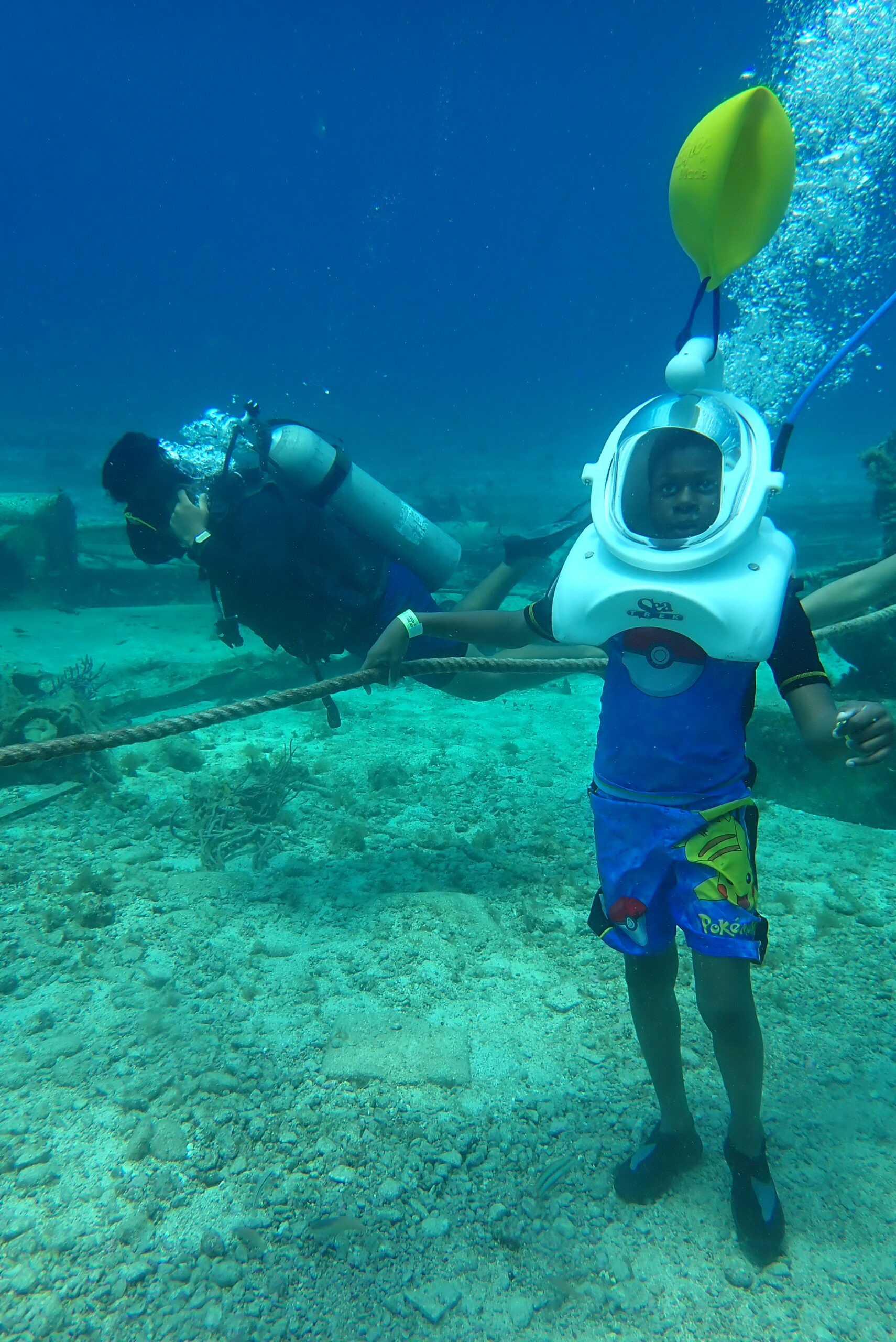Helmet diving is an easy way to explore underwater without prior scuba diving experience. You can immerse yourself in vibrant marine life by wearing a special helmet that allows you to breathe normally while walking along the ocean floor.
This adventure is accessible to people of all ages and doesn’t require strong swimming skills, making it an easier and less intimidating option than traditional scuba diving.
You can comfortably marvel at stunning underwater scenery by using a helmet attached to an air supply on the surface. Safety is a top priority, with guides ensuring a fun and secure experience. Dive in and experience the beauty and tranquility of life beneath the waves!
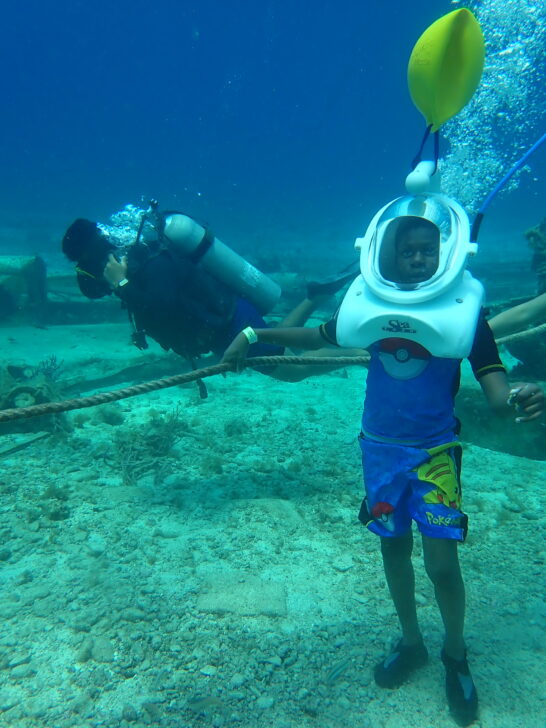
This post contains affiliate links that could result in a commission to this website (at no additional cost to you). Visit our Disclosures Page for more information.
What Is Helmet Diving?
Helmet diving, also known as Sea Trek, is a way to explore the underwater world without any significant swimming skills. It offers a simple and unique adventure that packs a great deal of fun into a relatively modest amount of time — perfect for cruise travelers.
With over 51 locations worldwide, you have plenty of options for your helmet-diving adventure. From the vibrant coral reefs of Boracay, teeming with colorful fish and unique marine species, to the crystal-clear waters of Cozumel, where you can encounter friendly sea turtles and stunning underwater landscapes, each destination offers a unique experience. (We most recently visited the Cozumel Sea Trek location and had a fabulous time!)
Qualifications
You can participate in a helmet diving tour without prior experience or swimming skills. You just need to be comfortable in the water and at least 8 years of age. You must generally be in good health. Not surprisingly, you will be required to provide a signed waiver.
The Helmet Diving Experience: A Step-by-Step Journey
In helmet diving, you wear a special helmet connected to a surface air supply. This allows you to breathe normally while walking on the seabed. Professional divers will guide you through the entire process. The whole experience typically lasts 20-30 minutes, making it convenient for cruise schedules.
Training and Orientation
The safety briefing typically lasts about 10 minutes.
You’ll typically undergo a short training session that covers important safety measures. This ensures you know how to use the equipment correctly.
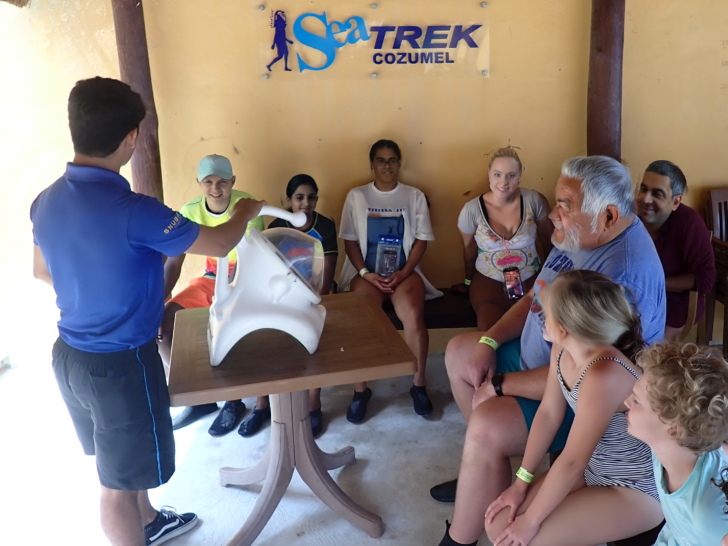
The briefing guide will demonstrate the SeaTREK helmet and explain simple techniques for equalizing ear pressure. He will also review breathing techniques– meaning you should breath normally in and out of your nose! You will also receive information on using simple hand signals for underwater communication
Effective underwater communication is essential for safety and coordination during helmet diving. Hand signals are the primary method of communication.
As you dive, familiarizing yourself with common signals can greatly improve your underwater experience. Here are some essential signals:
- OK Signal: Forming a circle with your thumb and index finger means “OK.”
- Problem Signal: Flat hand, palm down, tilting side to side signals a problem.
- Up or Down: Thumb up or down, respectively, indicates a desire to ascend or descend.
It’s important to ask questions if anything is unclear.
The goal is to ensure you feel confident and prepared for the dive.
Practical Tips: For the best experience, wear comfortable swimwear and water shoes. Follow the guide’s instructions closely, and don’t hesitate to ask questions during the safety briefing.
Making the Dive
When you begin your helmet diving adventure, you will descend a ladder a few steps until the water reaches mid-chest to shoulder level. At this point, a staffer will carefully lower the weighted helmet onto your shoulders.
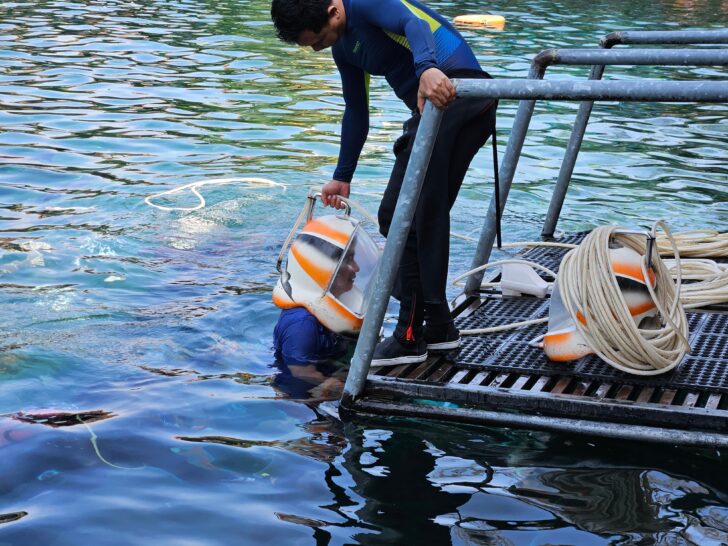
You will then continue to descend the ladder, step by step, with the assistance of a safety diver or your guide, ensuring a smooth and safe transition into the underwater world.
The helmet provides a continuous air supply, three times more than what you normally breathe on the surface. This ensures you can breathe comfortably and naturally through your nose without needing a mouthpiece.
Additionally, your entire head remains dry, and you should be able to wear glasses or contact lenses without any issues. The tour officially begins once you reach the bottom of the ladder, and the entire group is assembled on the sea floor.
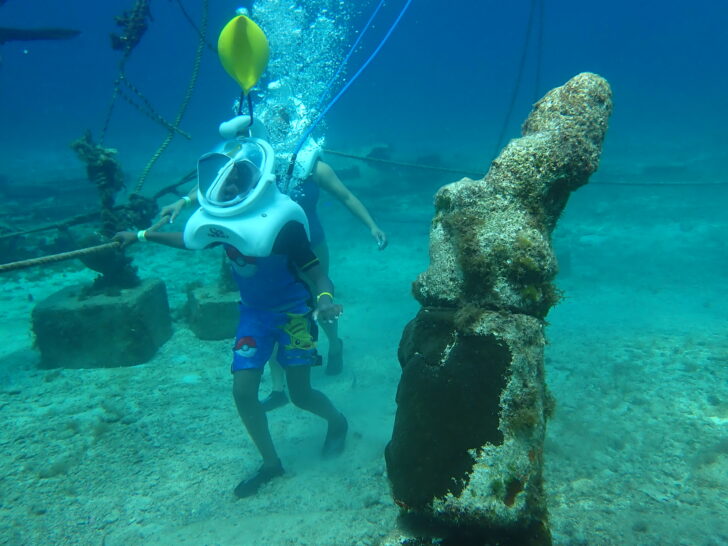
A guide and safety divers will accompany you throughout the experience as you walk underwater along a preset trail, usually marked with handrails or ropes.
This guided path provides a unique and unforgettable way to explore the underwater environment. There may be certain designated spots for photos.
SeaTREK tours may include a professional photographer or videographer to document your adventure (e.g., Cozumel).
The underwater tour lasts approximately 25 minutes, giving you ample time to enjoy the experience fully.
Difference Between Helmet Diving and Scuba Diving
Helmet diving differs from scuba diving in several ways.
In helmet diving, you don’t need any swimming skills. The helmet provides a continuous flow of air from the surface (unlike scuba diving, in which you carry an air tank on your back).
Scuba diving requires more extensive training and involves carrying more equipment. But it does allow for greater mobility and the ability to swim freely underwater.
In contrast, helmet diving is more accessible and requires less preparation, making it suitable for people of all ages and fitness levels. With helmet diving, you simply walk on the ocean floor and enjoy the view, making it a great option for those looking to easily experience the underwater world.
Here’s a quick comparison of helmet diving vs. scuba diving:
| Feature | Helmet Diving | Scuba Diving |
|---|---|---|
| Required Skills | No swimming skills needed | Swimming skills required |
| Equipment | Helmet with surface air supply | Air tank, mask, regulator |
| Training Time | Brief orientation | Extensive training |
| Mobility | Walking on the seabed | Free swimming |
| Age Requirement | 8 years and up | 10-12 years and up |
| Experience Level | Beginner-friendly | Requires certification |
Interacting with Marine Life
During your dive, you’ll encounter various forms of marine life. Colorful fish often swim close by, curious about the new visitors. The guides will likely have fish food available to attract more fish to visit.
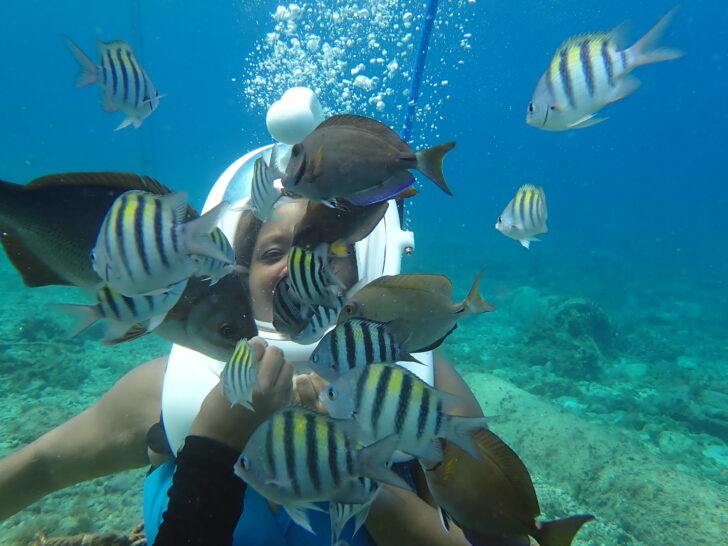
Coral reefs might also be part of your path, showcasing the beauty of underwater ecosystems. You’ll also see other fascinating creatures, from small invertebrates to larger fish. Guides know the local ecosystem and will point out interesting species.
Closing Thoughts
A guided underwater walking tour with a specially designed helmet offers an incredible way to explore marine life without requiring extensive training or diving skills. Connected to an air supply on the surface, the helmet allows you to walk along the seabed and breathe normally.
This unique adventure lets you see underwater creatures and coral reefs up close, making it a perfect activity for families and groups. Experience the thrill of an underwater adventure and create unforgettable memories.

Elaine Warren
Founder & Crew Chief
Elaine founded this website after publishing the book The Family Cruise Companion’s Guide to Cruising With Kids. (Second edition recently released!) She has sailed on 45 cruises (and counting). She loves helping families navigate their way to an adventure-filled, fun, and memorable vacation.

